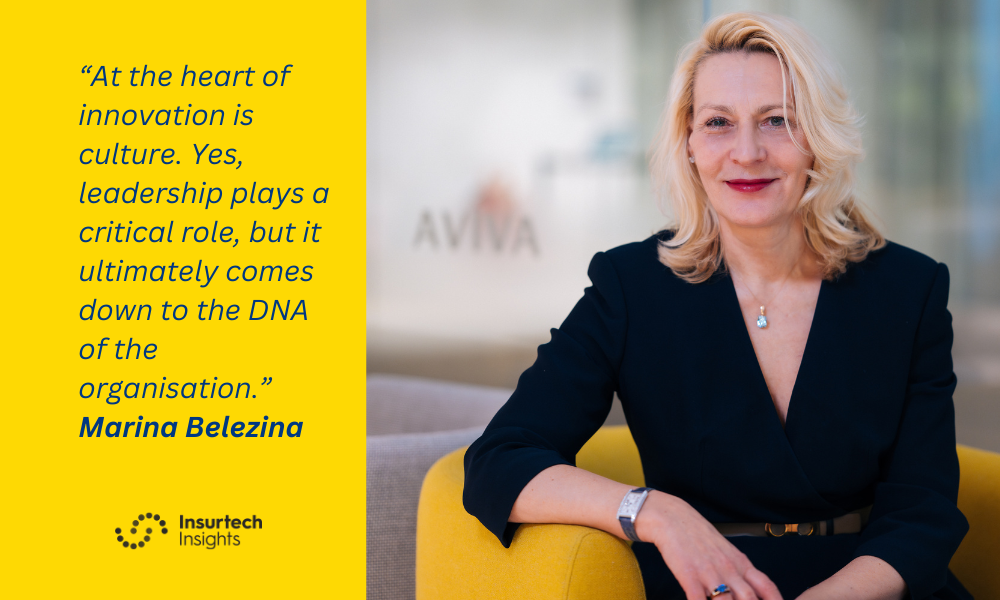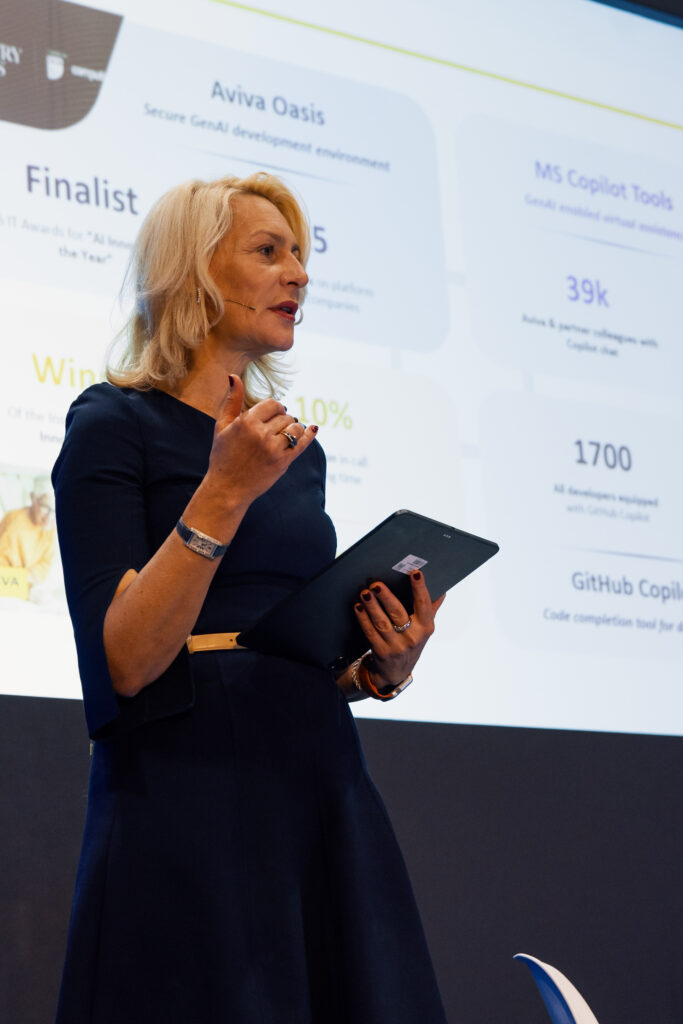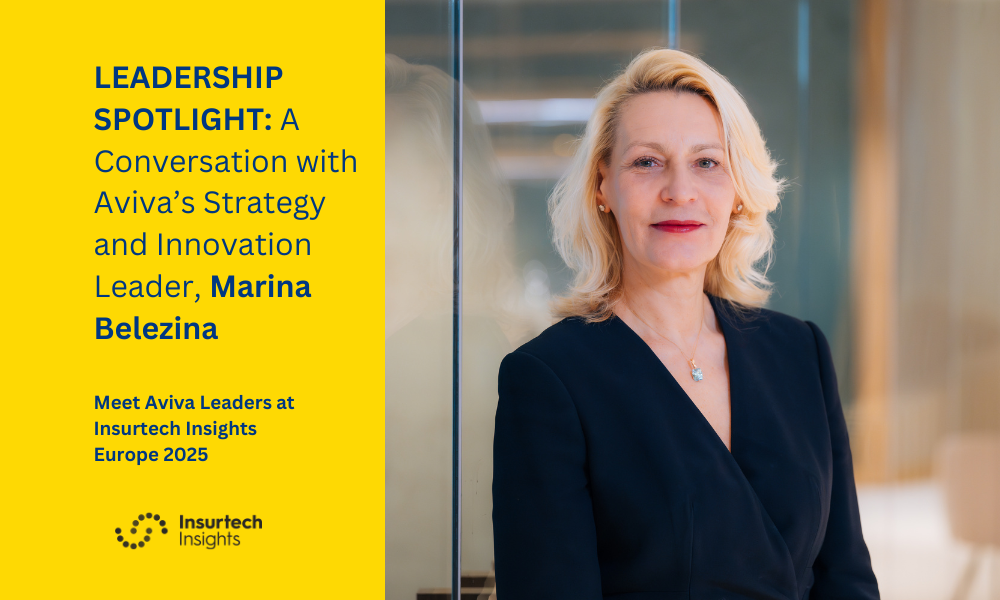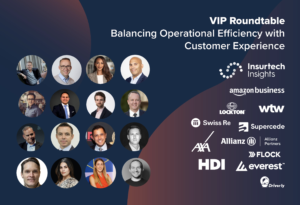As the Group Director of Strategy and Innovation at Aviva, Marina is at the forefront of shaping the company’s future, overseeing both strategic direction and the adoption of innovative solutions to fuel growth.
Before joining Aviva, she spent nearly two decades at Marakon, a leading strategic advisory firm, where she honed her expertise working with senior executives across the insurance and banking sectors in the UK, Europe, and North America. Her background in financial services and her deep understanding of both the market and customer needs provide a unique perspective on the challenges and opportunities in the industry today.
Insurtech Insights explores Marina’s journey from consultancy to corporate strategy, the changing landscape of financial services, and how Aviva is driving innovation to better serve its customers.
Tell us about your role at Aviva.
Sure. My role is centered around two main components: strategy and innovation. I oversee two teams that work closely together. Essentially, we partner with leaders across the business, as well as the CEO and board, to define the strategic direction and help build new growth engines through the adoption of innovation.
How did you transition into the insurance industry, given your background in business consultancy?
It’s actually a bit of a journey! I came to the UK 24 years ago from Russia to pursue my MBA at London Business School. After that, I joined Marakon, where I spent 19 years working primarily in their financial services practice. My time was split between banking and insurance, particularly wealth and life insurance. Then, I made the leap to Aviva.
What inspired you to make the move?
It’s a pretty typical story, honestly. I began working with Aviva and got really excited about what the company is doing – its customer strategy and the growth potential. Aviva is unique in a really exciting way. With over 16 million customers in the UK, we have a diversified product portfolio across insurance, wealth, and retirement. But it’s not just about the range of products; it’s about how we’re positioned. We’re almost more like a bank than a traditional insurer because we’re able to support our customers throughout their lifetime, meeting all kinds of needs along the way. That kind of opportunity is rare. Add to that an exceptional leadership team, and it made the decision pretty easy for me.

People often say the insurance industry is slow to adopt new ideas. What’s your take on this – and is it true?
I’d have to disagree when it comes to Aviva – we’re always innovating. Innovation comes in all sizes, big and small, but the key is that we never stop. It’s essential, not just to stay competitive, but also to keep up with the evolving needs, behaviors, and expectations of our customers.
Looking at the breadth of Aviva’s business, we’re not just competing with traditional players like Admiral or Legal & General—we’re also up against highly tech-savvy companies in areas like direct wealth. That means we need to be at the cutting edge of technology and digital advancements.
A great example is Aviva Zero, our carbon-conscious car insurance product on price comparison websites. It’s one of the fastest-growing propositions of its kind in the UK. In just three years, we’ve already sold more than one million policies. And the best part? We built it in-house in under six months—proof that we can move fast and lead the way in innovation.
What are the key factors, in your opinion, that enable companies to embrace new innovations from a culture perspective?
At the heart of innovation is culture. Yes, leadership plays a critical role, but it ultimately comes down to the DNA of the organisation. And as you know, culture isn’t something you can buy—it takes time to build. We’ve been on this journey for quite a while, and my team plays a key role in promoting innovation, providing the tools to track ideas, and creating an environment where experimentation can happen safely.
One way we foster this is through annual hackathons. Last year, we ran two major events; Agility Den – which is focused on how we operate internally and how we can become a more agile organisation, and the Hackathon. This is centered around customer-driven ideas, and it was our biggest one yet! Sponsored by Microsoft, LinkedIn, and Xbox, it generated hundreds of ideas from across the business.
One of the winning ideas, which we absolutely loved, was integrating policy details into electronic wallets on mobile phones. It’s incredibly simple yet highly effective for customers. A cross-functional team developed the idea, and we’ve since taken it forward—it’s currently being built, with travel insurance policies set to go live in Q1 this year. The more we invest in initiatives like this, the easier it becomes to drive innovation at scale.
What sets Aviva Apart when it comes to culture?
I think there are two factors sitting at the intersection of strategy and culture that make Aviva stand out. The first is Customer Obsession. Customer focus isn’t just part of our strategy; it’s deeply embedded in our organisational DNA. This means that ideas on how we can improve the customer experience naturally flow from within, without resistance. Some of the most innovative companies in the world—like FMCG giants—excel because they put customers first, and we take the same approach.
The second thing is a Growth Mindset. Growth is a core pillar of our strategy. To grow, you need new and fresh ideas—which is why we invest so much in fostering innovation.
What can the Insurance industry learn from the Financial Services space?
Looking at the insurance industry from a broader perspective, there’s no doubt that we’re playing catch-up compared to financial services. Having spent half my career in banking, I’ve seen firsthand how financial institutions embraced digital transformation earlier and with greater urgency.
The biggest lesson? Customer and technology must be at the heart of strategy. That’s something banks have mastered, and it’s an area where insurers need to accelerate.
“Just look at the pace of AI development and adoption. To put it into perspective, the internet took around four years to reach [approximately] 50 million users. Generative AI? It hit that milestone in a matter of weeks.”
Marina Belezina
Fortunately, Aviva has been ahead of the curve in digital transformation. For over a decade, we’ve been making significant investments to put technology at the core of our strategy. Even in just the last three years, we’ve heavily invested in customer experience transformation.
For example, we launched the next-generation MyAviva app, built on a modern platform with a robust data architecture, enabling a far more personalised customer experience. Customers love it—our online experience score is now above 70 percent, a 15 point increase versus the old app.
Our vision is to make this app the digital front door to everything Aviva – a critical part of our long-term strategy.
What’s your personal take on the role of technology?
Beyond customer experience, technology is critical for driving efficiency. Whether it’s modernising legacy tech and reducing the number of applications, or building enterprise capabilities with strategic partners like Salesforce, Snowflake, and AWS.
Leveraging AI and generative AI can enhance customer interactions, automate processes and advance sustainability efforts using tech-driven energy monitoring. We are fully committed to making tech a key enabler of our strategy.
What’s a recent example of this?
Creating a single, golden customer record – a unified view of each customer across our systems. This was a massive undertaking, but it’s a game-changer in how we serve customers.
With 250+ data scientists and around 3,000 colleagues in technology, we’re making some of the biggest investments in tech and AI in the industry. That’s how we stay ahead, and that’s how we continue to innovate.
This is something we, rightly, are very proud of.
AI is leading lots of innovation conversations. What are your thoughts on its trajectory over the next five years in the insurance space?
There’s no doubt that AI is going to be transformative for the insurance industry. In fact, I see it as a huge opportunity—not just to catch up with banks on digital innovation, but to leapfrog ahead.
Just look at the pace of AI development and adoption. To put it into perspective, the internet took around four years to reach [approximately] 50 million users. Generative AI? It hit that milestone in a matter of weeks. ChatGPT alone has scaled at an unprecedented rate.
And if we look at just the last two years, the leaps in AI capabilities have been incredible. When GenAI first emerged, its primary function was handling simple five-second tasks—and even that drove rapid adoption. Fast forward to today, and we’re working with models that are approaching master student-level intelligence, capable of handling complex workflows with ease.
But here’s the real game-changer: as AI becomes more sophisticated, it also becomes easier to use. Thinking about the partnership between Apple and OpenAI, the integration of GenAI into mobile phones will drive another massive wave of adoption, making it even more accessible for both businesses and consumers.
How do you think this will impact the workforce?
We’ve seen estimates suggesting that over 60% of roles will be impacted by GenAI. But it’s important to break that down. Some of this impact will come from automation – AI taking over repetitive, manual tasks.
But a greater share will come from augmentation – AI enhancing roles by allowing people to focus on what only humans can do best.
That’s exactly how we’re approaching AI at Aviva. Most of our early use cases focus on augmenting our colleagues’ work rather than replacing it.

Take medical underwriting, for example – one of our first AI-driven use cases that we’ve now successfully scaled across Aviva. Instead of spending hours manually summarising medical records, AI can instantly generate summaries, allowing teams in our Health business to focus on higher-value work and ultimately provide a better experience for customers.
And this is just the beginning. The potential for AI-driven transformation in insurance is enormous, and we’re only scratching the surface.
There’s a lot of noise about Agentic AI at the moment. What’s your take on that?
Let’s talk about what really happens when you’re put on hold during a claims call – that dreaded “please hold” moment.
Behind the scenes, the agent is jumping between multiple systems, trying to piece together all the relevant information about your claim. That’s where our AI-powered claims summarisation comes in. It pulls all the key details into a simple, easy-to-read timeline, allowing agents to focus on the customer rather than scrambling for information.
The result? At least a 10% reduction in call time, fewer complaints and follow-up calls, happier employees – because they can actually focus on helping customers instead of wrestling with systems.
This is just one live example. As you can imagine, we’re doing a lot more around agentic AI, building confidence in how we can best use the technology to deliver real benefits for our customers. Very exciting stuff!
Will AI fully replace human agents? I don’t think so. It’s going to be a blend, depending on the situation.
“If you’re reporting a bereavement or have just had a major accident, you want to talk to a real person – someone who can show empathy and provide reassurance.
Marina Belezina
But if you just need to change your address or check a policy detail, you probably don’t mind speaking to AI.”
If you’re reporting a bereavement or have just had a major accident, you want to talk to a real person – someone who can show empathy and provide reassurance.
But if you just need to change your address or check a policy detail, you probably don’t mind speaking to AI.
The key is knowing when to use AI and when human interaction is essential. Companies that get this balance right will deliver the best customer experiences in the future.
What direction is Aviva taking from an innovation perspective?
Our ambition isn’t just to be at the forefront of using technology—it’s to deliver real benefits to our customers through it. We think about transformation in three horizons.
Firstly, we started using technology to enhance existing processes, making them more efficient for both our customers and colleagues.
Like many others, we explored AI-powered coding tools to boost developer efficiency. We’ve now deployed GitHub Copilot to our 1,700 developers, equipping them with tools that speed up their work.
Beyond that, we have a significant number of pilot programmes underway, along with large-scale initiatives like claims summarisation, which improves both process efficiency and customer experience.
Secondly, as we gain confidence in what technology can do, we’re shifting our focus to transformation—not just improving existing processes, but reimagining them.
If we were designing an insurance company from scratch today, we wouldn’t build it the way it’s been done in the past. So, we’re exploring big, structural changes—rethinking services from the ground up with technology at the core.
Right now, we have several “speedboats”—small, agile teams—experimenting with ways to automate and redesign key processes. The goal is to test, learn, and scale at a pace we’re comfortable with.
Finally, we’re reinventing – but one step at a time.
Technology is evolving fast, but it comes with new risks and uncertainties. We have a responsibility to protect our customers, safeguard our data and ensure positive customer outcomes.
That’s why we’re moving forward thoughtfully, balancing innovation with responsibility.
Join Aviva Leaders at Insurtech Insights Europe 2025
Aviva leaders will be taking to the stage at Insurtech Insights Europe 2025 in London on March 19-20, to share insights and discuss the latest innovations and challenges facing the insurance industry. Join Arslan Hannani, Chief Innovation Officer, for the CIO Forum, Jason Chambers, Director of Digital Innovation, for the session entitled: Fast-Track Market Shift Adaptation: Rapid Adoption and Release with SaaS in Insurance, and Caspar Stops, London Market Cyber Underwriting Manager, in: From Niche to Mainstream: Paths to Scale in Cyber Insurance. For more information, visit here









